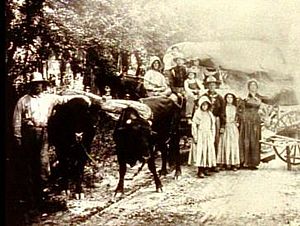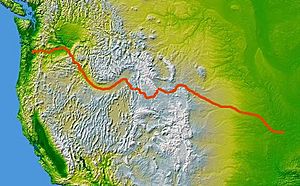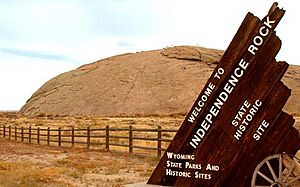Sager orphans facts for kids
The Sager orphans were seven children whose parents, Henry and Naomi Sager, died during their journey along the Oregon Trail in 1844. They were later adopted by Marcus and Narcissa Whitman, who were missionaries in what is now Washington. Sadly, the children were orphaned a second time in November 1847, when their new parents and two of the Sager brothers, John and Francis, died during the Whitman massacre.
Around 1860, Catherine Sager, the oldest daughter, wrote down her memories of their journey and life with the Whitmans. Her story is now seen as a very important and real account of the American westward migration.
The Sager children were (from oldest to youngest):
- John Carney Sager (born 1831 in Union County, Ohio)
- Francis "Frank" Sager (born 1833 in Union County, Ohio)
- Catherine Carney Sager (born April 15, 1835 in Union County, Ohio)
- Elizabeth Marie Sager (born July 6, 1837 in Union County, Ohio)
- Matilda Jane Sager (born October 6, 1839 in Buchanan County, Missouri)
- Hannah Louise "Louisa" Sager (born 1841 in Platte County, Missouri)
- Henrietta Naomi "Rosanna" Sager (born May 30, 1844 along the Oregon Trail in present-day Kansas)
Contents
Starting Their Journey West
Henry Sager, the father, was known for being restless. Before 1844, he moved his family three times. They started in Virginia, then moved to Ohio, and later to Indiana. In 1839, they settled on a farm in Platte County, Missouri. Henry also worked as a blacksmith.
Henry and Naomi decided to move to Oregon. Naomi believed Oregon had a healthier climate. In late 1843, they sold their farm and moved to St. Joseph, Missouri. This town was a popular starting point for the Oregon Trail. They stayed there for the winter. Naomi was pregnant with their seventh child at this time. In March 1844, Henry joined a group of pioneers called The Independent Colony.
Life on the Oregon Trail
In late April 1844, The Independent Colony began its journey. This group included 300 people in 72 covered wagons. They crossed the Missouri River and started the 2,000-mile (3,200 km) trip along the Oregon Trail. The group was led by Captain William T. Shaw. The Sagers joined the wagon train at Weston, Missouri.
After five weeks of travel, Naomi gave birth to their seventh child, a girl named Henrietta. Naomi was very weak after the birth and took a long time to get her strength back.
On July 4, 1844, the pioneers celebrated Independence Day by the Platte River. A few days later, Naomi was badly hurt when the Sager wagon overturned in shallow water while crossing the river. But the pioneers kept moving forward. By the end of July 1844, the wagon train passed Chimney Rock. This was a famous landmark in what is now Nebraska. It showed them that the Great Plains were almost behind them and the Rocky Mountains were ahead.
A few hours before reaching Fort Laramie, Catherine had an accident. She caught her dress on an axe handle when she jumped out of the moving wagon. Her left leg was trapped under a heavy wheel and broken in several places. This was a very serious injury, especially with the limited medical care available then. However, Henry and Dr. Dagon, a German doctor, treated her right away. Her leg was saved, but she had to stay inside the wagon for the rest of the trip. Dr. Dagon stayed with the Sagers from Fort Laramie onward to care for her. The wagon train continued, and a few days later, they reached Independence Rock in Wyoming. Some travelers carved their names into the granite rock there.
Losing Their Parents
On August 23, 1844, the wagon train reached South Pass. This high pass is on the Continental Divide. As they went down into the Green River valley, some travelers became sick with a serious illness called "camp fever" (typhus). Henry Sager was one of those who fell ill.
After crossing the Green River, Henry became much worse. He was laid up in the wagon with Catherine. Catherine later wrote that Captain Shaw found her father crying. Henry said he was dying and was worried about his family. His wife was sick, the children were young, and Catherine might be crippled. They had no relatives nearby, and a long journey was still ahead. He begged Captain Shaw to take care of his family. Henry was buried by the Green River in a simple coffin.
Naomi, still weak from childbirth and grieving Henry, now had to care for all seven children alone. She soon caught the same illness. With a high fever, she became confused. She asked Dr. Dagon to take the children to Marcus Whitman, a missionary in the Walla Walla Valley of what is now southeastern Washington. Naomi died 26 days after Henry, near present-day Twin Falls, Idaho. Her last words were, "Oh Henry, if you only knew how we have suffered." There was no wood for a coffin, so she was buried wrapped in a bedsheet. John, the oldest child, carved "Naomi Carney Sager, age 37" on a wooden headboard to mark her grave. The children, the youngest only three months old and the oldest fourteen, were now orphans.
The adults in the wagon train worked together to care for the Sager children for the rest of the trip. William Shaw and his wife Sally especially helped care for and feed the older six children. Another woman cared for baby Henrietta. The train ran out of food except for meat, and the Shaws even shared their last loaf of bread with the Sager children. Henrietta, the baby, was very sick when they finally reached the Whitman mission. Everyone worried she might not survive.
Life at the Whitman Mission
Marcus Whitman was a doctor and a Protestant missionary. In 1836, he and Narcissa traveled west with other missionaries. They set up several missions, including their own settlement. It was in the Walla Walla Valley, near the present-day city of Walla Walla, Washington. This area was home to the Nez Percé and Cayuse Native American tribes. The Cayuse called the mission site Waiilatpu, which means "place of the rye grass" in their language. Marcus farmed and provided medical care, while Narcissa started a school for Native American children.
Life at the Whitman Mission was peaceful at first. However, over time, disagreements grew between the Whitmans and the Cayuse. The Cayuse felt that Marcus Whitman had not paid for the land where the mission was built, as promised. Also, the Whitmans tried to limit the Cayuse's time in their mission house, which meant the Cayuse sometimes received less medical care than white settlers.
In 1837, Narcissa Whitman had a daughter, Alice Clarissa, who sadly died two years later. To feel like a family again, Narcissa began caring for other children. Soon, four children were living with them, including daughters of mountain men Joseph Meek and Jim Bridger.
In early October 1844, The Independent Colony reached the Whitman Mission. The Sager orphans found a new home with the Whitmans. Narcissa really wanted to adopt baby Henrietta, but not the other children. Marcus wanted to adopt the Sager boys. William Shaw reminded them of his promise to Naomi to keep her children together. Marcus Whitman then signed a contract to keep all seven children together at least until spring. By spring, Narcissa had grown close to the other girls and wanted to keep them too. In July 1845, Marcus officially gained legal care of all seven children.
Francis Sager soon decided to run away. He went to live with settlers in a nearby valley. The Whitmans were very strict, and Francis did not like living with them.
In the fall of 1847, a measles epidemic spread through the Cayuse villages. The cold, damp weather in November 1847 made the illness worse. Half of the Cayuse tribe died, including most of their children. Marcus and Narcissa Whitman treated both white settlers and Cayuse people. However, the Cayuse had become less trusting of the Whitmans' medical care. Tensions grew between the settlers and the Cayuse, especially as so many Cayuse people were dying from the disease.
On November 29, 1847, a group of Cayuse men attacked the settlement at Waiilatpu. Eleven people at the mission died in this tragic event. This included Marcus and Narcissa Whitman, and the Sager brothers, John and Francis. Francis had been at the mission that day to bring a cow from the valley. Fifty-four women and children were captured and held for ransom. This group included the daughters of Joseph Meek and Jim Bridger, and all the Sager girls. Several prisoners died while captured, mostly from the measles epidemic. Louisa Sager died on December 5, 1847, at age six. One month after the attack, on December 29, 1847, Peter Skene Ogden from the Hudson's Bay Company arranged for the release of the forty-nine surviving prisoners. They were exchanged for blankets, shirts, rifles, ammunition, tobacco, and flints. The survivors were then brought to Fort Vancouver.
After the Whitman Attack
The four remaining Sager orphans were taken to Oregon City. The girls were separated and grew up with different families.
- Catherine lived with the Rev. William and Mrs. Roberts. In October 1851, she married Clark Pringle, a Methodist minister. After her marriage, Elizabeth and Henrietta came to live with the Pringles. They had a farm near Salem, Oregon and raised eight children. About ten years after arriving in Oregon, Catherine wrote her story of the Sager family's journey west. She hoped to earn money to start an orphanage in memory of Narcissa Whitman, but she never found a publisher. Catherine died on August 10, 1910, at 75 years old. Her children and grandchildren saved her handwritten story, and it is now considered a very important account of the American westward migration.
- In 1855, Elizabeth married farmer William Fletcher Helm. They had nine children. She lived in Prineville, Oregon. Elizabeth died in Portland, Oregon on July 19, 1925, at 88 years old.
- Matilda had five children with her first husband, who was a miner. After he died, she married Matthew Fultz, a farmer, and had three more children. They lived in Siskiyou County, California. After Fultz died, she married a man named Delaney. She spent her later life with a daughter in California, where she died on April 13, 1928, at 89 years old.
- Henrietta was originally named Rosanna. When the children went to live with the Whitmans, her name was changed to Henrietta Naomi to honor her parents. She first lived with the Morgan Kees family for three years. Then she joined her older sisters at the Pringles' farm. Later, she left to join her uncle Solomon Sager's traveling entertainment group. Henrietta was married twice. She sadly died at 26 years old after being accidentally shot during a gunfight involving her husband.
In 1897, over 3,000 people attended the 50th anniversary of the attack at the mission grounds. Catherine Sager Pringle, Elizabeth Sager Helm, and Matilda Sager Delaney, the last surviving Sager orphans, were honored guests.
In Popular Culture
The children's book On to Oregon! by Honoré Morrow tells a fictionalized version of the Sager children's story.
The actors Harold Daye and Rickie Sorensen played John and Francis Sager in a 1958 TV episode called "Head of the House." This episode was part of the show Death Valley Days, hosted by Stanley Andrews. In the story, the Sager orphans travel to the Whitman mission after their parents die. They get help from the famous frontier scout Kit Carson (played by Morgan Jones). Roy Barcroft played the wagon master, Captain Shaw.
The 1974 film ‘’Seven Alone’’ also tells the Sager family's story, starring Stewart Petersen.





